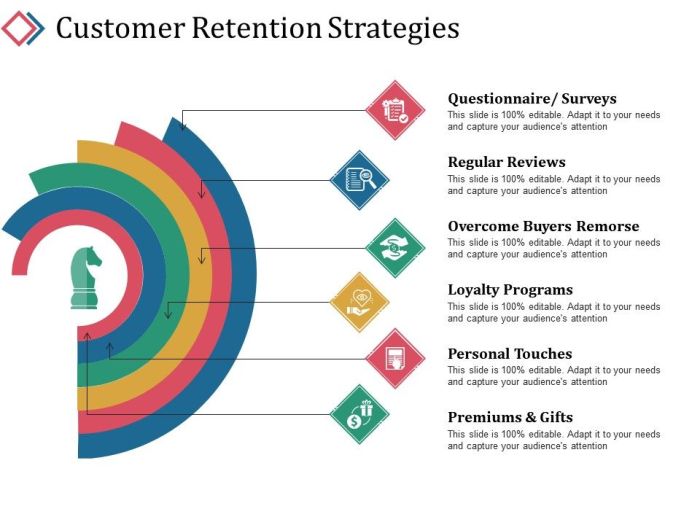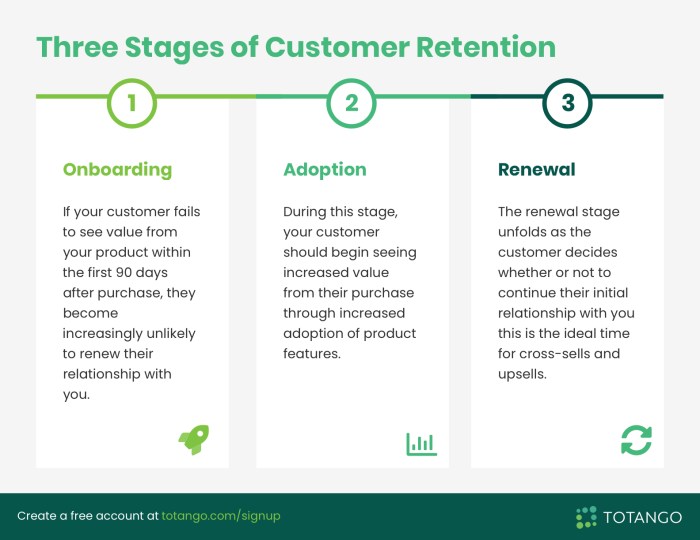Developing a Customer Retention Plan dives into the essence of keeping customers loyal and satisfied. From understanding their behavior to implementing personalized experiences, this guide will equip you with the tools to boost your business growth.
Importance of Customer Retention

Customer retention is a critical aspect of business growth, as it focuses on retaining existing customers rather than solely acquiring new ones. By nurturing and maintaining relationships with current customers, businesses can benefit in various ways, such as increased revenue, brand loyalty, and positive word-of-mouth referrals.
Examples of Successful Businesses
- Apple: Known for its strong customer loyalty through quality products and exceptional customer service.
- Amazon: Utilizes personalized recommendations and efficient delivery services to keep customers coming back.
- Starbucks: Creates a welcoming atmosphere and rewards program to enhance customer retention.
Impact on Long-Term Profitability
Customer retention directly impacts long-term profitability by reducing marketing costs associated with acquiring new customers. Loyal customers are more likely to make repeat purchases and spend more over time, leading to a higher customer lifetime value. Additionally, satisfied customers are more likely to recommend the business to others, further driving revenue growth.
Understanding Customer Behavior

Understanding customer behavior is crucial in developing a successful customer retention plan. By analyzing how customers interact with your business, you can identify patterns, preferences, and pain points that will help you tailor your retention strategies effectively.
Key Metrics for Tracking Customer Engagement and Satisfaction
Tracking customer engagement and satisfaction is essential for measuring the success of your retention efforts. Here are some key metrics to consider:
- Customer Lifetime Value (CLV): This metric helps you understand the total revenue a customer is expected to generate throughout their relationship with your business.
- Net Promoter Score (NPS): NPS measures customer loyalty and satisfaction by asking customers how likely they are to recommend your business to others.
- Customer Churn Rate: This metric indicates the percentage of customers who stop doing business with you over a specific period.
- Customer Satisfaction Score (CSAT): CSAT measures how satisfied customers are with your products or services.
Role of Customer Feedback in Understanding Needs and Preferences
Customer feedback is a valuable source of information that can help you understand your customers’ needs and preferences. By collecting and analyzing feedback, you can gain insights into what is working well and what areas need improvement. This information can guide you in developing personalized retention strategies that address the specific needs of your customers.
Creating Personalized Customer Experiences: Developing A Customer Retention Plan
Personalized customer experiences play a crucial role in retaining customers as they make individuals feel valued and understood. By tailoring products, services, and interactions to meet the specific needs and preferences of each customer, businesses can build strong relationships and foster loyalty.
Examples of Personalized Marketing Strategies, Developing a Customer Retention Plan
- 1. Personalized Recommendations: Utilizing customer data to recommend products or services based on past purchases or browsing history.
- 2. Birthday Offers: Sending personalized birthday discounts or gifts to customers to make them feel special.
- 3. Customized Content: Creating targeted content such as emails, newsletters, or social media posts tailored to the interests of individual customers.
Leveraging Technology for Personalization
Technology plays a key role in enabling businesses to deliver personalized experiences at scale. By leveraging customer relationship management (CRM) systems, artificial intelligence (AI), and data analytics, companies can gather insights on customer behavior and preferences to tailor their offerings accordingly.
With advanced technology, businesses can track customer interactions across various touchpoints and create seamless, personalized experiences throughout the customer journey.
Implementing Loyalty Programs
Implementing loyalty programs is a strategic way to retain customers and encourage repeat business. By offering rewards, discounts, or exclusive perks, businesses can build a loyal customer base that keeps coming back.
Types of Loyalty Programs
- Points-Based Programs: Customers earn points for purchases that can be redeemed for rewards or discounts.
- Tiered Programs: Customers move up levels based on their spending, unlocking more benefits as they progress.
- Discount Programs: Offering exclusive discounts or promotions to loyal customers.
Designing a Successful Loyalty Program
- Understand Your Customers: Tailor the program to match your customers’ preferences and buying behavior.
- Make it Easy to Join: Simplify the registration process to encourage more customers to sign up.
- Promote Your Program: Ensure customers are aware of the benefits and rewards they can earn.
- Track and Analyze Data: Use customer data to personalize offers and improve the effectiveness of the program.
Communication Strategies for Customer Retention
Effective communication plays a crucial role in retaining customers as it helps in building strong relationships, addressing customer needs, and fostering loyalty. By maintaining regular communication, businesses can stay top of mind with their customers and provide them with relevant information and updates.
Maintaining Regular Communication with Customers
- Send personalized email newsletters to update customers about new products, promotions, and company news.
- Utilize social media platforms to engage with customers, respond to their queries, and showcase your brand personality.
- Implement a customer feedback system to gather insights and improve your products or services based on customer preferences.
Using Various Communication Channels to Engage Effectively
- Utilize SMS marketing to send targeted offers and reminders to customers, keeping them engaged and informed.
- Host webinars or online events to provide value-added content to customers and create interactive experiences.
- Offer live chat support on your website to provide instant assistance to customers and address their concerns in real-time.
